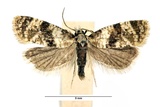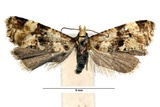Phalonidia manniana (Fischer von Röslerstamm, 1839) Species
Last modified: Nov. 22, 2025, 4:53 p.m.
In the past it was assumed that it was only one species but since the publication of Marko Mutanen and colleagues in Zootaxa 3262: 1–21 DNA barcodes reveal that the widespread European tortricid moth Phalonidia manniana (Lepidoptera: Tortricidae) is a mixture of two species, we knew that what has hitherto been called Phalonidia manniana actually consists of a complex of two closely related species:
Phalonidia maniana (Fischer von Röslerstamm, 1839) and
Phalonidia udana (Guenée, 1845) (Mutanen et al. 2012).
A fairly common species in Belgium, mainly distributed in the northern part.
Details
- Classification
- Family: Tortricidae > Subfamily: Tortricinae > Tribus: Cochylini > Genus: Phalonidia > Species: Phalonidia manniana
- Vernacular names
- Muntbladroller (NL), Wasserminzen-Blattroller (DE)
- First mention in Belgium
- De Fré Ch. 1858. Catalogue des Microlépidoptères de la Belgique. — Annales de la Société entomologique belge 2: 45–162. On page 97.
- Status
-
Native
Distribution
Imago
Wingspan male 10–13 mm, female 11–13,5 mm. This species has the forewing median fascia straighter than in Phalonidia udana, and the fascia is usually suffused with blackish scales from dorsum to costa. The basal and sub-basal fasciae form a distinct rectangular blotch on the costa in P. manniana, this blotch is suffused with fuscous.
Similarly, the subterminal fascia in P. manniana has fuscous suffusion on the costa. The darkening of the veins in the apical part of the forewing in P. manniana gives it a reticulate appearance which is lacking in Phalonidia udana.
Both species vary in the intensity of the wing markings and the extent of dark suffusion on both sides of the wings. However, when series are compared, the differences mentioned will aid in identification.
This is of little use in the field, therefore study of the genitals is necessary for identification.
Genitalia
The shape of the median process of the transtilla is diagnostic and it is relatively short and broad in the male genitalia.
Bionomics
It hibernates full-fed in the stem of the food plant from October. Pupation in the stem, in a cocoon of silk and frass. The adults are active at dusk and later come to light.
Flight periods
The adults have usually been observed from early May till late August.
Observed on
- Host plant (species):
- Mentha aquatica
- Host plant (genera):
- Lycopus
The larva lives in the stem of Mentha aquatica or Lycopus europaeus.
Habitat
It inhabits damp habitats, river banks, ditches and freshwater margins.




